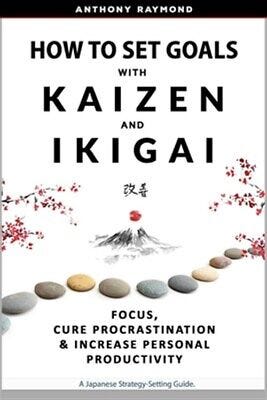Book Review - How to Set Goals with Kaizen & Ikigai
Setting chess goals using new techniques
In the realm of chess, where strategy, foresight, and precision reign supreme, the pursuit of mastery can be an arduous journey. As an avid chess enthusiast, I've often found myself grappling with the challenge of setting clear goals for my study and improvement in the game. It's easy to become ensnared in a web of distractions, procrastination, and doubts about the effectiveness of my efforts. That's when I stumbled upon "How to Set Goals with Kaizen & Ikigai." It felt like the guiding hand I needed to navigate the intricate labyrinth of chess improvement and self-growth.
In "How to Set Goals with Kaizen & Ikigai," the author skillfully navigates the complexities of motivation, goal setting, and self-improvement. The book offers a profound exploration of the human psyche and the hurdles we face in our pursuit of meaningful objectives.
Key Concepts
The concept of Ikigai, often translated as one's "reason for living" or "passion," serves as a central theme. It encourages readers to remain open to new experiences and curiosities, emphasizing the importance of finding work and activities that bring true meaning to life. The questions posed throughout the book challenge readers to evaluate their passions, vocations, missions, and professions, urging them to uncover their unique Ikigai.
Procrastination, a common adversary in goal setting, is dissected into four categories—distraction, mental fatigue, anxiety, and negative emotional associations. The book offers practical strategies to combat these procrastination triggers, such as time blocking, reducing distractions, and understanding the psychology behind procrastination.
Kaizen, the philosophy of continuous improvement through small, daily steps, takes center stage. The book outlines the six principles of Kaizen, encouraging readers to start with small, manageable actions and maintain a commitment to improvement, regardless of setbacks. The emphasis on daily progress and the importance of consistency are highlighted, offering a blueprint for achieving long-term goals.
The book extends its application beyond personal development into the workplace. Eight principles for implementing Kaizen in professional settings are detailed, focusing on fostering a culture of continuous improvement, making small bets on big ideas, and eliminating wasteful practices. These principles can help individuals and organizations enhance productivity and efficiency.
The book also addresses health and wellness, providing tips for improving dietary habits, managing calorie intake, and reducing sedentary behavior. These tips align with the Kaizen philosophy of small, sustainable changes leading to significant improvements over time.
Summary
This insightful book, "How to Set Goals with Kaizen & Ikigai," delves deep into the psychology of motivation, offering profound insights and practical strategies for goal setting and continuous improvement. It encourages readers to uncover their true calling, their Ikigai, and apply the principles of Kaizen to steadily progress toward their objectives. For a chess enthusiast like me, this book serves as a beacon of guidance. It has the potential to transform not only how I set and achieve my chess-related goals but also how I approach self-improvement in all aspects of my life.
As I embark on my chess journey armed with the wisdom from this book, I look forward to implementing the principles of Kaizen to enhance my study habits. Breaking down complex openings and endgames into smaller, manageable components, and dedicating daily, consistent effort to master them, aligns perfectly with the Kaizen philosophy. By measuring my progress ritualistically, applying the "little bet" principle to explore new chess strategies, and fostering a mindset of continuous improvement, I aim to elevate my chess game to new heights. This book has not only opened my eyes to the possibilities but has also provided me with a roadmap to turn those possibilities into tangible achievements on the chessboard.


